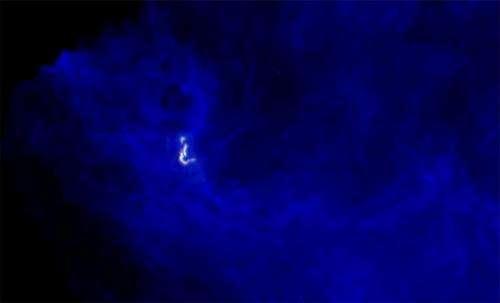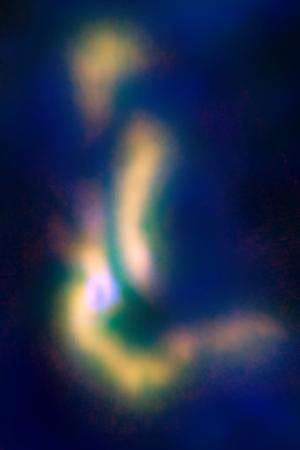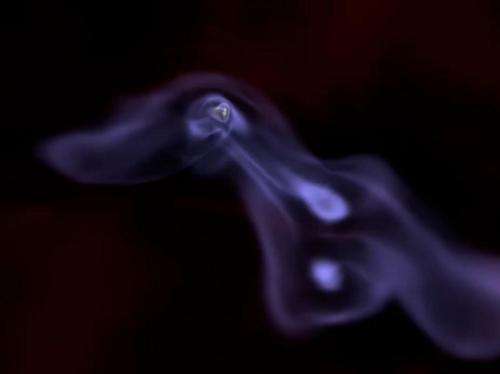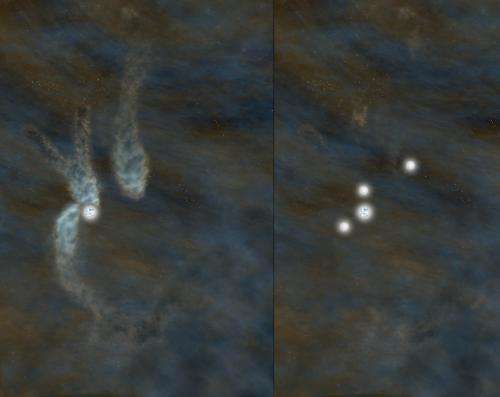Large scale Herschel image of the dust in the region in blue, with the dense gas low resolution image in green, and the dense gas high-resolution image displaying filaments in red. Credit: B. Saxton (NRAO/AUI/NSF)
For the first time, astronomers have caught a multiple-star system in the beginning stages of its formation, and their direct observations of this process give strong support to one of several suggested pathways to producing such systems.
The scientists looked at a cloud of gas some 800 light-years from Earth, homing in on a core of gas that contains one young protostar and three dense condensations that they say will collapse into stars in the astronomically-short period of 40,000 years. Of the eventual four stars, the astronomers predict that three may become a stable triple-star system.
"Seeing such a multiple star system in its early stages of formation has been a longstanding challenge, but the combination of the Very Large Array (VLA) and the Green Bank Telescope (GBT) has given us the first look at such a young system," said Jaime Pineda, of the Institute for Astronomy, ETH Zurich, in Switzerland.
The scientists used the VLA and GBT, along with the James Clerk Maxwell Telescope (JCMT) in Hawaii, to study a dense core of gas called Barnard 5 (B5) in a region where young stars are forming in the constellation Perseus. This object was known to contain one young forming star.
When the research team led by Pineda used the VLA to map radio emission from methane molecules, they discovered that filaments of gas in B5 are fragmenting, and the fragments are beginning to form into additional stars that will become a multiple-star system.
"We know that these stars eventually will form a multi-star system because our observations show that these gas condensations are gravitationally bound," Pineda said. "This is the first time we've been able to show that such a young system is gravitationally bound," he added.
Close up of Image 1 to focus in the region forming the stars. Credit: B. Saxton (NRAO/AUI/NSF)
"This provides fantastic evidence that fragmentation of gas filaments is a process that can produce multiple-star systems," Pineda said. Other proposed mechanisms include fragmentation of the main gas core, fragmentation within a disk of material orbiting a young star, and gravitational capture. "We've now convincingly added fragmentation of gas filaments to this list," Pineda added.
The condensations in B5 that will produce stars now range from one-tenth to more than one-third the mass of the Sun, the scientists said. Their separations will range from 3,000 to 11,000 times the Earth-Sun distance.
A triple star system forming within a dense gas filament in a numerical simulation modeling a group of forming stars. The color indicates the gas density, where lighter colors are higher densities. Rhe image is about 10,000 astronomical units across where the projected separations between the three objects is about 2,000 and 4,000 AU. Credit: UMass Amherst
The astronomers analyzed the dynamics of the gas condensations and predict that, when they form into stars, they will form a stable system of an inner binary, orbited by a more-distant third star. The fourth star, they suggest, will not long remain part of the system.
Artist impression of the results. Left panel shows the star and three dense gas condensations system. Right panel shows the system after the stars are formed out of the condensations. Credit: B. Saxton (NRAO/AUI/NSF)
"Nearly half of all stars are in multiple systems, but catching such systems at the very early stages of formation has been challenging. Thanks to the combination of the VLA and the GBT, we now have some important new insight into how multiple systems form. Our next step will be to look at other star-forming regions using the new capabilities of the VLA and of the Atacama Large Millimeter/submillimeter Array (ALMA) in Chile," Pineda said
In addition to Pineda, the international research team included members from the U.S., the UK, Germany, and Chile. The astronomers reported their findings in the 12 February edition of the scientific journal Nature.
More information: Pineda JE, Offner SSR, Parker RJ, Arce HG, Goodman AA, Caselli P, Fuller GA, Bourke TL, Corder SA. The formation of a quadruple star system with wide separation, Nature, published online 11 February 2015, dx.doi.org/10.1038/nature14166
Journal information: Nature
Provided by National Radio Astronomy Observatory



























